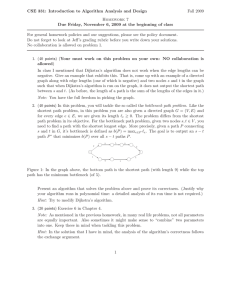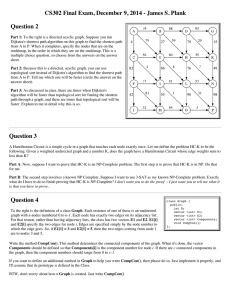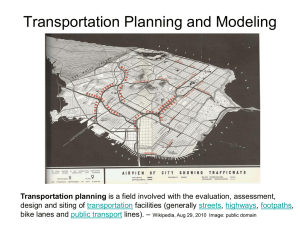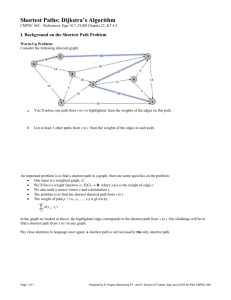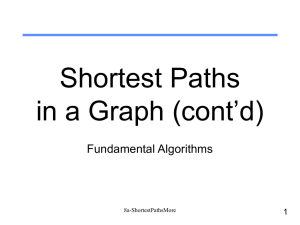Traffic Assignment
advertisement
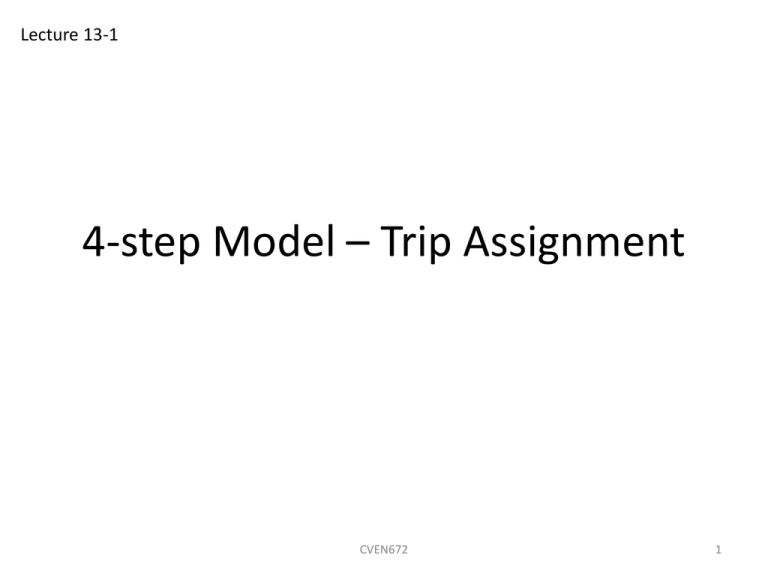
Lecture 13-1
4-step Model – Trip Assignment
CVEN672
1
Trip Assignment
Definition
Assign Tij onto alternative routes on the network to predict the
Link flows and to evaluate the network performance.
CVEN672
2
Trip Assignment
Generalized Cost = function of time, distance, $$ + possibly others.
From the user’s perspective; shortest path (stochastic vs.
deterministic)UE
From the planner’s perspective: minimize the network wide travel cost
SO
j
i
CVEN672
3
Trip Assignment: Link Performance
Fucntion
Each path has an associated Link performance function (LPF):
Typical forms:
t = t0eV/C
t = t0ab(V/C)
Most common from the Bureau of Public Roads (BPR)
t = t0(1 + a(V/C)b)
which becomes when linear (b = 1, a = aC/t0): t = t0 + aV
CVEN672
4
Trip Assignment
Four classes of TA methods:
1.
2.
3.
4.
ALL-or-NOTHING Assignment for uncongested network (constant cost)
[Dijkstra: Shortest path algorithm] find the shortest path and assign all
travels on the SP between a pair of OD.
User Equilibrium (Wardrop principles)
Every traveler is on the shortest path to the destination. No user can be
better off by unilaterally changing to a different route.
Stochastic TA (due to “perceived” costs, lack of info for users)
Users do not have perfect real time information about cost. Their route
choice decisions have uncertain factor.
Dynamic assignment (how about time variable???)
Traffic do not happen on the roads at one single instance of time. Early
travel decisions have impact on later traffic congestions. The
interactions over time are considered.
CVEN672
5
Shortest Path (Dijkstra)
Assuming a known network with a known deterministic link performance,
the objective is to find a path from an origin to a destination at the least
cost.
Shortest path calculations are idealistic, but are most fundamental to the
network flow problem and to the network traffic assignment problem.
Many sophisticated algorithms are built with the shortest path
algorithm.
There are many variations (Dijkstra, Moore), but all get to the same results.
The complexities are different slightly.
CVEN672
6
Notations
•
•
•
•
•
•
N Set of nodes
M set of unlabeled notes
Bar(M) set of unlabeled nodes
ni ith node in consideration
C(ni,nj) cost of travel from node i to node j.
C(nj) cost of travel from the home node to
node j.
CVEN672
7
Shortest Path (Dijkstra)
CVEN672
8
Label L(ni) = [predecessor, cost]
CVEN672
This is the
algorithm to
summarize based
on the example
9
Shortest Path (Dijkstra)
CVEN672
10
DIJKSTRA’S
ALGORITHM
• Greedy Algorithm
– Greedy algorithms use problem solving methods based on actions to see if there’s
a better long term strategy. Dijkstra’s algorithm uses the greedy approach to solve
the single source shortest problem. It repeatedly selects from the unselected
vertices, vertex v nearest to source s and declares the distance to be the actual
shortest distance from s to v. The edges of v are then checked to see if their
destination can be reached by v followed by the relevant outgoing edges.
• Disadvantages
– The major disadvantage of the algorithm is the fact that it does a blind
search there by consuming a lot of time waste of necessary resources.
– Another disadvantage is that it cannot handle negative edges. This leads
to acyclic graphs and most often cannot obtain the right shortest path.
CVEN672
11
Exercise: find the shortest path from
AE
CVEN672
12
All-or-nothing Assignment, use Dijkstra to find S.P. for each O/D pair and then
assign all flow to it
A-C = 400; A-D = 200; B-C = 300; B-D = 100
CVEN672
13
Some math background to the
Dijkastra’s Algorithm (optional)
• Linear programming
min cij xij
d_o
ij
x
– LP to inset later
oj
1,
j
x x
• Dual program
ij
i
x
is
jk
0,j N \{o, s}
k
1.
i
max d s d 0
s.t.
d j d o coj , j N \{o}
d j di cij , i, j N \{o}
CVEN672
14

